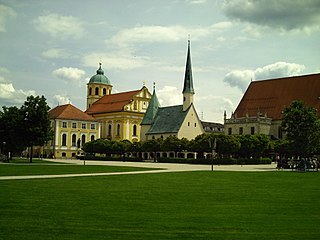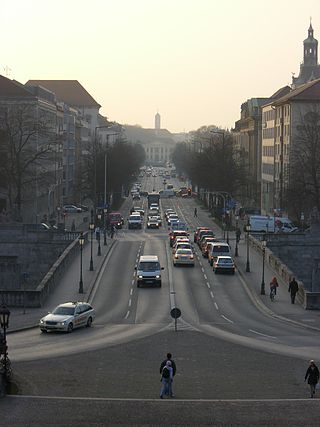
The Maximilianeum, a palatial building in Munich, was built as the home of a gifted students' foundation but since 1949 has housed the Bavarian State Parliament.

The Maximilianeum, a palatial building in Munich, was built as the home of a gifted students' foundation but since 1949 has housed the Bavarian State Parliament.
The Maximilianeum was initially an educational foundation set up by King Maximilian II of Bavaria in 1852 to prepare gifted students for the civil service. Construction of the building was the initiative of King Maximilian II in 1857, [1] with Friedrich Bürklein the lead architect.

The Maximilianeum sits grandly and as a focal point on the bank of the Isar River above Maximilian Bridge at the eastern end of Maximilianstrasse, [2] a royal avenue dotted with Neo-Gothic palaces influenced by the English Perpendicular style.
Weight problems delayed completion until 1874, [1] and the façade, which had been conceived as Neo-Gothic, needed to be altered; Gottfried Semper was entrusted with the adjustments, resulting in the final quasi-Renaissance appearance decorated with arches, columns, mosaics, and niches filled with busts. Until 1918, it also housed a "historical gallery" and the royal page school.
The building was significantly damaged by bombing during the Second World War, [3] but was rebuilt.
The foundation still exists. Each year six to eight male students receive scholarships, free room and board at the Maximilianeum, and the opportunity to study abroad and take part in language courses. In 1980, Albrecht, Duke of Bavaria established a comparable scholarship for female students. [4] The Maximilianeum has an exchange program with Balliol College, Oxford. [5]
The Bavarian state government took up occupancy in 1949. [3] The much less visible rear of the edifice has been extended in motley fashion to provide new parliamentary office space, in 1958, 1964, 1992, and again in 2012, each time with a different architectural approach. In June 2015, the Bavarian Parliament named the entrance hall of the Maximilianeum after Friedrich Bürklein. [6] Periodically exhibitions are hosted.

Ludwig I or Louis I was King of Bavaria from 1825 until the 1848 revolutions in the German states. When he was crown prince, he was involved in the Napoleonic Wars. As king, he encouraged Bavaria's industrialization, initiating the Ludwig Canal between the rivers Main and the Danube. In 1835, the first German railway was constructed in his domain, between the cities of Fürth and Nuremberg, with his Bavaria joining the Zollverein economic union in 1834. After the July Revolution of 1830 in France, Ludwig's previous liberal policy became increasingly repressive; in 1844, Ludwig was confronted during the Beer riots in Bavaria. During the revolutions of 1848 the king faced increasing protests and demonstrations by students and the middle classes. On 20 March 1848, he abdicated in favour of his eldest son, Maximilian.

Ingolstadt is an independent city on the Danube in Upper Bavaria with 139,553 inhabitants. Around half a million people live in the metropolitan area. Ingolstadt is the second largest city in Upper Bavaria after Munich and the fifth largest city in Bavaria after Munich, Nuremberg, Augsburg and Regensburg. The city passed the mark of 100,000 inhabitants in 1989 and has since been one of the major cities in Germany. After Regensburg, Ingolstadt is the second largest German city on the Danube.

The Ludwig Maximilian University of Munich is a public research university in Munich, Germany. Originally established as the University of Ingolstadt in 1472 by Duke Ludwig IX of Bavaria-Landshut, it is Germany's sixth-oldest university in continuous operation.

Maximilian II reigned as King of Bavaria between 1848 and 1864.

Maximilian I Joseph was Duke of Zweibrücken from 1795 to 1799, prince-elector of Bavaria from 1799 to 1806, then King of Bavaria from 1806 to 1825. He was a member of the House of Palatinate-Birkenfeld-Zweibrücken, a branch of the House of Wittelsbach.

The Landtag of Bavaria, officially known in English as the Bavarian State Parliament, is the unicameral legislature of the German state of Bavaria. The parliament meets in the Maximilianeum in Munich.

Altötting is a town in Bavaria, capital of the district Altötting of Germany. For 500 years it has been the scene of religious pilgrimages by Catholics in honor of Mary, including a visit by Pope John Paul II in 1980 and one by Pope Benedict XVI in 2006.

The Residenz in central Munich is the former royal palace of the Wittelsbach monarchs of Bavaria. The Residenz is the largest city palace in Germany and is today open to visitors for its architecture, room decorations, and displays from the former royal collections.

The Kingdom of Bavaria was a German state that succeeded the former Electorate of Bavaria in 1806 and continued to exist until 1918. With the unification of Germany into the German Empire in 1871, the kingdom became a federated state of the new empire and was second in size, power, and wealth only to the leading state, the Kingdom of Prussia.

Georg Friedrich Christian Bürklein was a German architect and a pupil of Friedrich von Gärtner.

Au-Haidhausen is the 5th borough of the German city of Munich, Bavaria. It is formed by the Au and Haidhausen districts.

This article gives an overview about the architecture of Munich, Germany.

The Prinzregentenstraße in Munich is one of four royal avenues and runs parallel to Maximilianstraße and begins at Prinz-Carl-Palais, in the northeastern part of the Old Town. The avenue was constructed from 1891 onwards as a prime address for the middle-class during the reign of Luitpold, Prince Regent of Bavaria and is named in his honour. The square in the eastern part of the street is named Prinzregentenplatz.

The Ludwigstraße in Munich is one of the city's four royal avenues next to the Brienner Straße, the Maximilianstraße and the Prinzregentenstraße. The avenue is named after King Ludwig I of Bavaria. The city's grandest boulevard still maintains its architectural uniformity envisioned as a grand street "worthy the kingdom" as requested by the king. The Ludwigstraße has served for state parades and funeral processions.

The neoclassical Brienner Straße in Munich is one of four royal avenues next to the Ludwigstraße, the Maximilianstraße and the Prinzregentenstraße. The boulevard was constructed from 1812 onwards, during the reigns of Maximilian I Joseph of Bavaria and his successor Ludwig I, in accordance with a plan by Karl von Fischer and Friedrich Ludwig von Sckell. The avenue is named after the Battle of Brienne.

The Maximilianstraße in Munich is one of the city's four royal avenues next to the Brienner Straße, the Ludwigstraße and the Prinzregentenstraße. It starts at Max-Joseph-Platz, where the Residenz and the National Theatre are situated, and runs east-west. Planned and begun in 1850 by King Maximilian II of Bavaria, the street takes his name. The lead architect was Friedrich Bürklein. Today, Maximilianstraße has the distinction of the highest retail rents in Germany.
Bavaria, one of the states of Germany, has a multiparty system dominated by the Christian Social Union in Bavaria (CSU). Bavaria has long been a bastion of conservative politics in Germany, with the Christian Social Union has won every election of the state parliament since 1946 and having almost a monopoly on power. Every Minister-President since 1957 has been a member of this party. On the other hand the bigger and more liberal, or rather social democratic, cities, especially Munich, have been governed for decades by the Social Democratic Party of Germany (SPD) until recently the second biggest party. In 2018 the Alliance 90/The Greens which have been represented in the state parliament since 1986, became the second biggest political party in the Landtag and in 2020 the biggest party in the Munich City Council. From the historical point of view, older Bavaria was one of the most liberal, predominantly Roman Catholic states until the rather rural areas of Swabia and Franconia were added in 1814/15 at the Congress of Vienna.

Haidhausen is a quarter of Munich, Germany. It is now part of the borough—or stadtbezirk—number 5 Au-Haidhausen.

Carl von Effner, also Karl von Effner, Carl Joseph von Effner and Carl Effner was gardener to the Bavarian court, later Königlich Bayerischer Hofgärtendirektor, and landscape gardener.
The Wittelsbacher Palais was located in Munich at the northeast corner of the Brienner Strasse and the Türkenstraße. Today, a building of the BayernLB is located at the site of the palace. A copy of one of two stone lions at the entrance area is the only keepsake of the palace.